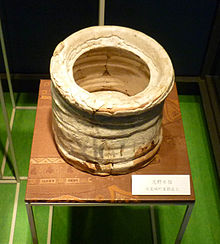Shino pottery


Shino ceramics ( Japanese 志 野 焼 , Shino-yaki ) refers to oribe ceramics, a type of Mino ceramics that has been produced in Gifu Prefecture (formerly: Mino Province ) since the Azuchi Momoyama period . Shino ceramics are characterized by a white feldspar glaze of unequal thickness and with small pinholes and cracks in the glaze, the so-called "lemon skin " ( 青 柚 肌 , yuzuhada ). For Shino ceramics, a special moxa clay of the gairomenendo ( 蛙 目 粘土 ) type is used, which is processed in tunnel ovens ( anagama ) at low temperatures and long firing times . The Shino ceramics and the technology of their production are declared in Japan as an " important intangible cultural asset ".
overview
The name of the Shino pottery, which emerged in the 16th century, the Momoyama period, is often traced back to the tea master and incense expert Shino Sōshin ( 志 野 宗 信 ,? -1480). Tea bowls ( tenmoku ) like those made in China at the time of the Song Dynasty were among the few pottery still preserved today, which were mainly made in the vicinity of the cities of Kani and Toki . The aim of the potters was to imitate the appearance of Chinese (celadon) porcelain through the opaque and white ash glaze. These ceramics were largely without decoration. In the course of time, however, a form of under glass painting to which iron oxide was used developed for the first time. Fine red-brown lines adorned the ceramics with their mouse-gray to white glaze.
One of the now rare old Shino ceramics is the tea bowl U no hanagaki ( 卯 花墻 ), which was declared a national treasure .
The earliest use of the term "Shino tea bowl" can be found in the Tsuda Sōgyū chatō nikki ( 津 田宗 及 茶湯 日記 , about "Diary of the Tsuda Sōgyūs tea ceremonies") of the merchant Tsuda Sōgyū . There the term is used more than 200 times between 1553 and 1586.
Types of Shino pottery
- Decorless Shino ceramics ( 無 地志 野 , muji shino ) without picture pattern or decoration, i. Usually just a thick white glaze
- Mouse-gray Shino ceramic ( 鼠 志 野 , nezumi shino ) with decorations etched through the glaze ( engobe ) using different metals that produce reddish-brown or gray patterns when fired
- Red Shino ceramics ( 赤 志 野 , aka shino ) with the same technique as in the mouse-gray Shino, red patterns
- Pink-colored Shino ceramics ( 紅 志 野 , beni shino ) are applied to the patterns using iron (III) oxide and yellowish clay in combination with a red glaze, creating a pink-colored ceramic
- Shino ceramics with picture patterns ( 絵 志 野 , e-shino ) first underglaze painting with materials containing brown iron or limonite (so-called oni-ita )
- Shino pottery made from mixed clay ( 練 り 上 げ 志 野 , neriage shino ) Pottery made by mixing and kneading white and red clay
- Shino oribe ceramics ( 志 野 織 部 , shino oribe ) originally the preliminary stage of Shino ceramics; today a ceramic that, unlike the old Shino ceramic, is fired in modern multi-chamber slope kilns
- Indigo blue Shino ceramic ( 藍色 志 野 , ai-iro oribe ) New development from the 1990s with indigo-colored engobe and white glaze
literature
- The six old ovens . In: Gabriele Fahr-Becker (Ed.): East Asian Art . 2nd (reprint) edition. Tandem Verlag, 2011, ISBN 978-3-8331-6099-8 , pp. 593-598 .
- Anneliese and Wulf Crueger: Paths to Japanese Ceramics . 2nd Edition. Ernst Wasmuth Verlag, Tübingen, Berlin 2012, ISBN 978-3-8030-3359-8 , pp. 182-184, 321 .
Individual evidence
- ↑ Gabriele Fahr-Becker (Ed.): Ostasiatische Kunst , p. 594
- ↑ a b Anneliese and Wulf Crueger: Paths to Japanese Ceramics , 2012, pp. 182–184
- ↑ 蛙 目 粘土 . In: ブ リ タ ニ カ 国際 大 百科 事 典 小 項目 事 典 at kotobank.jp. Retrieved January 16, 2015 (Japanese).
- ↑ 志 野 宗 信 . In: ブ リ タ ニ カ 国際 大 百科 事 典 小 項目 事 典 at kotobank.jp. Retrieved January 16, 2015 (Japanese).
- ↑ 志 野 茶碗 〈銘 卯 花墻 / › . In: Cultural Heritage Online. Cultural Affairs Office , accessed January 15, 2015 (Japanese).